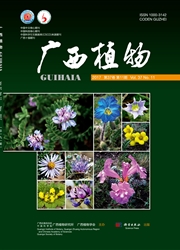

 中文摘要:
中文摘要:
该研究以苏丹草品系S722和Sa的成熟种子为外植体、MS培养基为基础培养基,2,4-D和NAA各3个浓度共6个处理对这两个苏丹草品系成熟种子进行愈伤诱导,探讨不同品系在不同植物生长物质浓度及植物生长物质组合中诱导愈伤组织和继代培养以及分化的能力。结果表明:苏丹草S722和Sa成熟种子的愈伤诱导率差异不显著,平均诱导率为17.19%。诱导培养基中2,4-D浓度为0.5或1 mg·L^-1时,诱导效果最佳,而添加NAA不能提高愈伤诱导率。在继代培养中,设定2,4-D和6-BA各两个浓度共4个处理组合,处理1(2,4-D 1mg·L^-1+6-BA 0mg·L^-1)的继代培养效果最佳。为了解不同植物生长物质对愈伤分化的影响,设定6-BA、NAA各两个不同浓度、KT 3个不同浓度共5个处理组合对继代培养的愈伤进行分化培养。在5个处理中,处理1(6-BA 2 mg·L^-1+NAA 0mg·L^-1+KT 0mg·L^-1)对S722成熟种子诱导的愈伤分化率最高,达33.3%。在这两个苏丹草品系中,S722更容易分化培养。综上结果表明,2,4-D浓度为1 mg·L^-1时诱导愈伤和继代培养效果较好,6-BA浓度为2 mg·L^-1时分化效果较好。另外,针对不同苏丹草品系进行组织培养和植株再生时,适当调整植物生长物质浓度能提高植株再生的成功率。
 英文摘要:
英文摘要:
In the study,mature seeds of sudangrass strains S722 and Sa as explants were used to study the factors affecting callus induction,subculture and differentiation using different combinations of plant growth substances and MS( Murashige and Skoog) media for basic media. Six treatment combinations,including three different levels of 2,4-D and NAA,were used to induce callus from mature seeds of two sudangrass strains in callus induction process. The results showed that the percentage of callus induction was not significantly different between the two sudangrass strains. And the average percentage of callus induction was 17.19% for the two sudangrass strains. The proper concentration of 2,4-D for callus induction was 0.5 or 1 mg·L^-1in MS media. The percentage of callus induction did not changed when NAA was added in basic media in callus induction process. The results showed that it was not helpful for callus induction when NAA was added in MS basic media. Four treatment combinations including two different concentrations of 2,4-D and 6-BA were used to subculture for induced callus. The best combination was treatment No.1,which included 1 mg·L^-1 2,4-D and 0 mg·L^-1 6-BA. When 6-BA was added in MS basic media,callus became brown and the growth of callus was also inhibited. These results indicated that 6-BA inhibited the growth of callus in subculture process when 6-BA was added in MS basic media. To gain a better understanding about the effects of different combinations of plant growth substances in callus differentiation,five treatment combinations including two different 6-BA and NAA concentrations and three different concentrations of KT were used to differentiate for callus when the callus had been subcultured. Treatment No.1 was the best combination in the five treatment combinations. And the differentiation rate of callus from mature seeds of S722 was 33.3% when 2 mg·L^-16-BA was added in MS basic media. It was the highest differentiation rate when the concentration of 6-BA was added in media. Callus fr
 同期刊论文项目
同期刊论文项目
 同项目期刊论文
同项目期刊论文
 期刊信息
期刊信息
